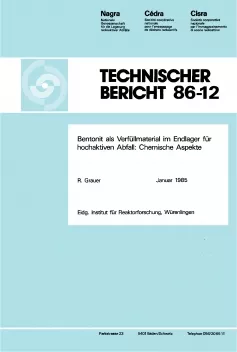
Technical Report NTB 86-12
Bentonite as a backfill material in the high-level waste repository: chemical aspects
The present Nagra concept for disposal of high-level waste foresees emplacing the steel containers enclosing the borosilicate glass in tunnels of 3.7 m diameter at a depth of 1000 to 1500 m. These tunnels are to be backfilled with compacted bentonite, a clay with a high montmorillonite content. Bentonites are suitable as a backfill due to, inter alia, their swelling capability, their low hydraulic conductivity and their sorption properties.
This report is restricted to those chemical aspects of the backfill material which can affect the behaviour of a repository system: swelling capability, sorption properties and long-term stability.
Under repository conditions, the swelling of montmorillonite upon water inflow is primarily innercrystalline. At present, there is no microscopic model which gives a quantitative description of this process. However, on the basis of equilibrium thermodynamics, relationships can be deduced between swelling pressure and experimentally more easily determinable water vapour sorption isotherms and heats of immersion.
Cation adsorption, which is important for nuclide retention in the repository, can be described by appropriate models. However, for various reasons, interpretation of published sorption data is rarely possible from a theoretical viewpoint and direct diffusion measurements on compacted bentonite are therefore preferable to the use of sorption data.
It can be concluded from natural analogue studies and from laboratory experiments that the properties of the backfill material will not alter significantly over a period of 106 years. Nevertheless in the long term, the formation of mixed-layer illite/montmorillonite cannot be ruled out. Such mixed-layer clays still have good swelling and sorption properties. Given the quantity ratios foreseen, no adverse changes due to radioactive decay are to be expected.
The interactions between the bentonite and the container corrosion products must, in the absence of literature data, be investigated experimentally. The type of reaction products expected (iron-containing clay minerals) and the high bentonite/iron ratio lead to the conclusion that the function of the backfill needs not be impaired by these processes.
Because of its better stability, a calcium bentonite is preferable to the sodium variant. Low iron content is desirable because, under reducing conditions, the surface charge of the montmorillonite is increased by reduction of iron (III). Organic and sulphidic contaminants should also be kept to a minimum.
